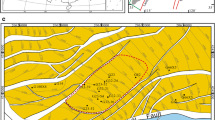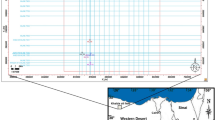Abstract
Modification of local stress orientation is an interesting issue for fluid migration and seal integrity at the faulted region of Assam Gap holding major oil/gas fields of India. Main objective is to scrutinize the stress pattern at the faulted blocks in this seismic gap. Geomechanical characterization of the study area has been carried out by integrating seismic and well log data through velocity model. A fresh approach adopting inverted post-stack seismic section tied with wells is considered to map the geomechanical parameters and stress magnitudes of the study area. The 3D structural model considers the geomechanical layers delineated by the mapped rock mechanical properties and local faults revealed in post-stack seismic sections. The 3D finite element model proposed in this study allows the computation of stress orientation, constraining deformation at the north facing edge and imposing the regional stress field towards NE–SW direction. The pattern of stress orientation shows the limited variation in stress direction across the geomechanical layers paralleling the regional stress direction of NE–SW. However strong stress rotation amounting about 20° is observed near the fault blocks and scattered rotation ranging from 20 to 90° in the fault plane. The model predicted stress direction is validated with the stress direction at well location from Fullbore Micro resistivity Imager data.













available at comparable depths of (a) M1 and (b) M3.
Similar content being viewed by others
References
Alam J, Chatterjee R and Dasgupta S 2019 Estimation of pore pressure, tectonic strain and stress magnitudes in Upper Assam Basin: a tectonically active part of India; Geophys. J. Int. 216 659–675.
Al-Chalabi M 1997 Time–depth relationships for multilayer depth conversion; Geophys. Prospect. 45(4) 715–720.
Al-Qahtani M and Rahim Z 2001 A mathematical algorithm for modeling geomechanical rock properties of the Khu and Pre-Khu reservoirs in Ghawar field; In: Proceedings of the SPE Annual Technical Conference and Exhibition, Bahrain, pp. 123–129.
Bell J S 1996 Petro geoscience. 1: In-situ stresses in sedimentary rocks (part 1): measurement techniques, Geosci. Can. 23(2) 85–100.
Bilham R and England P 2001 Plateau ‘pop-up’ in the great 1987 Assam Earthquake; Nature 410 806–809.
Chatterjee R and Mukhopadhyay M 2002 Petrophysical and geomechanical properties of rocks from the oilfields from Krishna-Godavari and Cauvery Basins, India; Bull. Eng. Geol. Environ. 61 169–178.
Chatterjee R and Mukhopadhyay M 2003 Stress modeling for the oil and gas fields of Krishna-Godavari and Cauvery basins, India, using finite element technique; Petrophysics 44(5) 342–350.
Chatterjee R and Mukhopdhyay M 2002 In-situ stress determination using well log data for the oil fields of the Krishna-Godavari basin; Petrophysics 43 26–27.
Chatterjee R 2008 Effect of normal faulting on in-situ stress: A case study from Mandapeta field, Krishna–Godavari basin, India; Earth Planet Sci. Lett. 269 458–467.
Das B and Chatterjee R 2017 Wellbore stability analysis and prediction of minimum mud weight for few wells in Krishna–Godavari Basin, India; Int. J. Rock Mech. Min. Sci. 93 30–37.
Das B and Chatterjee R 2018 Mapping of pore pressure, in-situ stress and brittleness in unconventional shale reservoir of Krishna–Godavari Basin; J. Natural Gas Sci. Eng. 50 74–89.
Dasgupta S, Chatterjee R and Mohanty S 2016 Magnitude, mechanisms and prediction of abnormal pore pressure using well data in the Krishna–Godavari Basin, east coast of India; AAPG Bull. 100(12) 1833–1855.
Eaton B A 1972 Graphical method predicts geopressures worldwide; World Oil 182 51–56.
Fjær E 2009 Static and dynamic moduli of a weak sandstone; Geophysics 74 WA103–WA112.
Gogoi T and Chatterjee R 2019 Estimation of petrophysical parameters using seismic inversion and neural network modeling in Upper Assam basin, India; Geosci. Front. 10(3) 1113–1124.
Gogoi T and R Chatterjee 2018 Neural network analysis and seismic-velocity model building in Upper Assam Basin, India: An aid to reservoir-characterization study; Conference: SEG Technical Program Expanded Abstracts 2018, August, https://doi.org/10.1190/segam2018-2998230.1, pp. 3161–3165.
J Cook, Frederiksen R A, Hasbo K, Green S, Judzis A, Martin J W, Suarez-Rivera R, Herwanger J, Hooyman P, Lee D, Noeth S, Sayers C, Koutsabeloulis N, Marsden R, Stage M G and Tan C P 2007 Rocks matter: Ground truth in geomechanics; Oilfield Rev. 19 36–55.
Kayal J R, Arefiev S S, Barua S, Hazarika D, Gogoi N, Kumar A, Chowdhury S N and Kalita S 2006 Shillong plateau earthquakes in northeast India Region: complex tectonic model; Curr. Sci. 91 109–113.
Kent W N and Dasgupta U 2004 Structural evolution in response to fold and thrust belt tectonics in northern Assam. A key to hydrocarbon exploration in the Jaipur anticline area; Mar. Pet. Geol. 21(7) 785–803.
Khattri K, Wyss M, Gaur V K, Saha S N and Bansal V K 1983 Local seismic activity in the region of the Assam Gap, northeast India; Bull. Seismol. Soc. Am. 73 459–470.
Lei T, Sinha B K and Sanders M 2012 Estimation of horizontal stress magnitudes and stress coefficients of velocities using borehole sonic data; Geophysics 77(3) 181–196.
Mukerji T, Jørstad A, Avseth P, Mavko G and Granli J R 2001 Mapping lithofacies and pore-fluid probabilities in a North Sea reservoir: Seismic inversions and statistical rock physics; Geophysics 66(4) 988–1001.
Nokes C R 2011 Finite numerical modelling of stress deflections around salt Diapirs in the Gulf of Mexico, University of Adelaide, Honours thesis.
Pahari S, Singh H, Prasad I V S V and Singh R R 2008 Petroleum Systems of Upper Assam Shelf, India; Geohorizons 14–21.
Pandey A K, Kumar R, Shukla M, Negi A and Tandon A K 2013 Seismic velocity model building: An aid for better understanding of subsurface: a case study from Cambay basin, India: 10th Biennial International Conference & Exposition, SPG India, P408.
Perchikolaee S R, Shadizadeh S R, Shahryar K and Kazemzadeh E 2010, Building a precise mechanical earth model and its application in drilling operation optimization: A case study of Asmari Formation in Mansuri Oil Field; Proceedings of the SPE Annual Technical Conference and Exhibition, 8–10 June 2010, pp. 448–450, SPE 132204, Bahrain.
Plumb R 2000 The mechanical earth model concept and its application to high-risk well construction projects; In: Proceedings IADC/SPE Drilling Conference. Louisiana; 23–25 February 2000.
Plumb R A, Evans K F and Engelder T 1991 Geophysical log responses and their correlation with bed-to-bed stress contrasts in Paleozoic rocks, Appalachian plateau, New York; J. Geophys. Res. 96 14,509–14,528.
Rudnicki J W 1979 Rotation of principal stress axes caused by faulting; Geophys. Res. Lett. 6 135–138, https://doi.org/10.1029/GL006i003p00135.
Soleymani H and Riahi M-A 2012 Velocity based pore pressure prediction: a case study at one of the Iranian southwest oil fields; J. Petrol. Sci. Eng. 94–95 40–46.
Singha D K, Chatterjee R, Sen M K and Sain K 2014 Pore pressure prediction in gas-hydrate bearing sediments of Krishna–Godavari basin, India Pore pressure prediction in gas-hydrate bearing sediments of Krishna–Godavari basin, India; Mar. Geol. 357 1–11.
Singha D K and Chatterjee R 2014 Detection of overpressure zones and a statistical model for pore pressure estimation from well logs in the Krishna–Godavari Basin, India; Geochem. Geophys. Geosyst. 15 1009–1020.
Singha D K and Chatterjee R 2015 Geomechanical modeling using finite element method for prediction of in-situ stress in Krishna–Godavari basin, India; Int. J. Rock Mech. Min. Sci. 73 15–27.
Singha D K, Shukla P K, Chatterjee R and Sain K 2019 Multi-channel 2D seismic constraints on pore pressure- and vertical stress related gas hydrate in the deep offshore of the Mahanadi Basin, India; J. Asian Earth Sci. 180 (2019) 103882.
Tingay M, Hillis R, Swarbrick R, Morley C and Damit A 2008 Origin of overpressure and pore-pressure predictionin the Baram Delta province, Brunei; AAPG Bull. 93 51–74.
Trautwein B U, Schulze K C, Becker S, Kukla P A and Urai J L 2010 In situ stress variations at the Variscan deformation front – Results from the deep Aachen geothermal well; Tectonophys. 493 196–211.
Wang H F 2000 Theory of Linear Poroelasticity; Princeton University Press.
Yamamoto Y, Lin W, Oda H, Byrne T and Yamamoto Y 2013 Stress states at the subduction input site, Nankai Subduction Zone, using anelastic strain recovery (ASR) data in the basement basalt and overlying sediments; Tectonophys. 600 91–98.
Yin Z M and Rogers G C 1995 Rotation of the principal stress directions due to earthquake faulting and its seismological implications; Bull. Seismol. Soc. Am. 85(5) 1513–1517.
Zamora M, Sartoris G and Chelini W 1994 Laboratory measurements of ultrasonic wave velocities in rocks from the Campi Flegrei volcanic system and their relation to other field data; J. Geophys. Res. 99(B7) 13553–13 561.
Zoback M L 1992 Stress field constraints on intraplate seismicity ineastern North America; J. Geophys. Res. 97 11,761–11,782.
Acknowledgements
Authors are very much thankful to Oil India Ltd., for providing the data. The data is available at National Data Repository, India (https://www.ndrdgh.gov.in/NDR/) and can be accessed with permission from Oil India Ltd. Authors acknowledge the financial support from the Ministry of Earth Science through the R&D project MoES/P.O./(Seismo)/1(273) 2015 dated 16.03.16.
Author information
Authors and Affiliations
Contributions
Jenifer Alam conceived the presented idea and carried out the literature review, study design and result interpretation. Jenifer Alam and Triveni Gogoi have performed computations, modelling and manuscript preparation. Rima Chatterjee analyzed the results from the computations, supervised the methodology, reviewed, revised, provided inputs for improvement.
Corresponding author
Additional information
Communicated by Saibal Gupta
Rights and permissions
About this article
Cite this article
Alam, J., Gogoi, T. & Chatterjee, R. Geomechanical characterization of subsurface formations with stress rotation in Assam Gap, Northeast India. J Earth Syst Sci 130, 132 (2021). https://doi.org/10.1007/s12040-021-01640-z
Received:
Revised:
Accepted:
Published:
DOI: https://doi.org/10.1007/s12040-021-01640-z




